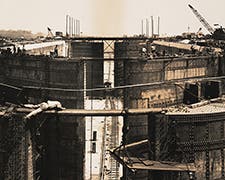The Lure of the Pacific
Panama and the Lure of the Pacific
Europeans dreamed of crossing the Isthmus of Panama from their first encounters, when Columbus and other explorers learned from Indigenous Americans about a vast open sea on the other side of the narrow strip of land. Columbus searched for a strait through which he could sail, while Balboa hiked across on foot and Magellan sailed through a strait at the tip of South America to reach the Pacific Ocean. Traveling by canoe up the Chagres River and then hiking down from the continental divide to the Pacific side became an established route for both surveyors and buccaneers. A railroad built in the middle of the nineteenth century turned a profit by transporting people on their way to California, lured by the prospect of gold.
Christopher Columbus
Columbus, in his fourth and last voyage in 1502, sailed the coast of the Isthmus of Panama in search of the “narrow place between two seas” that Indigenous Americans had described to him. He imagined a hidden strait that, of course, he failed to find. He finally departed for Spain in September 1504, getting no further in his quest of India than the coast of Panama. After sailing for some time along the shores of Panama and following the coast to the northeast, he reached the point now known as Porto Bello. Storms along the coast of Panama forced his ships into harbors, which showed him the richness of the country, but gave no hint at how thin was the strip of country that separated him from the great ocean on the other side.

